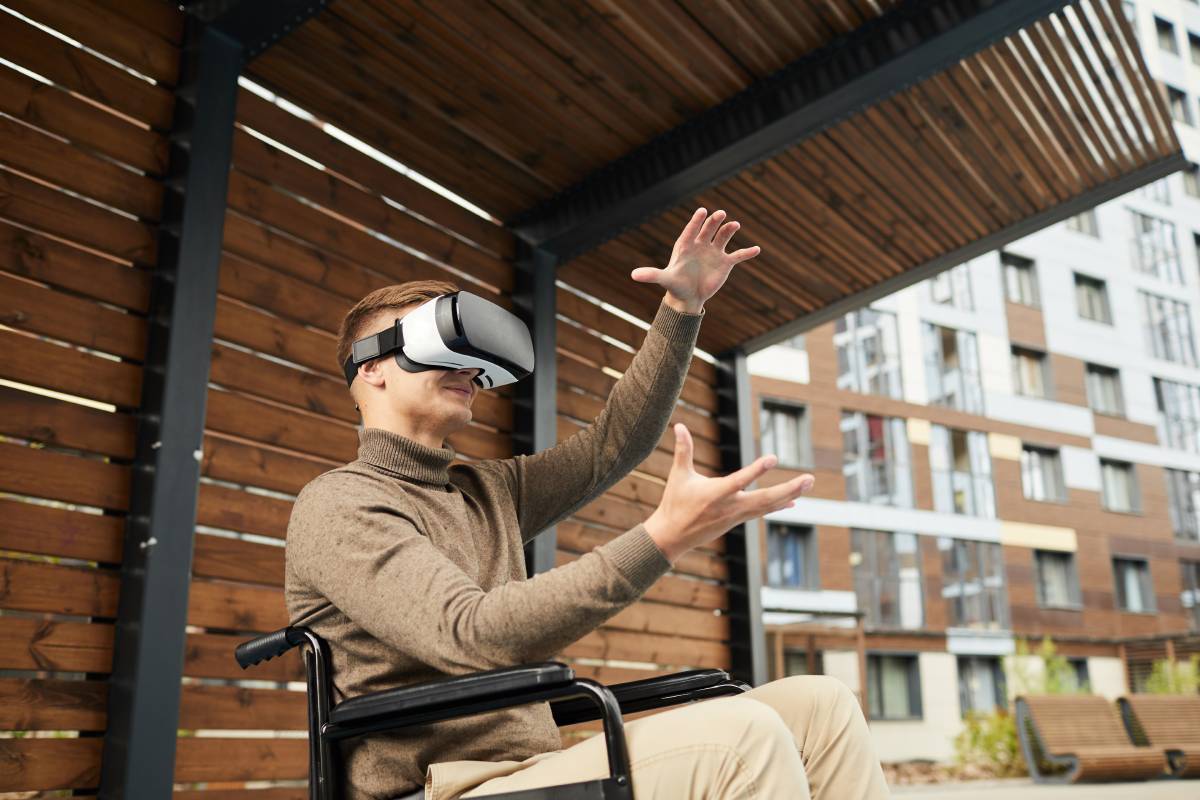Many forms of pain management involve medication, including over-the-counter drugs like acetaminophen and ibuprofen. In recent years, healthcare providers and society at large have realized the individual and social downsides of pain-relieving medication that have an addiction risk. Medical researchers are seeking new techniques for pain management that replace and supplement pharmaceutical methods. One technology-driven example is virtual reality therapy (VRT). In the clinical setting, VRT typically involves a virtual reality headset with pre-loaded software, like a game or a meditative scene [1]. The overarching conclusion from current research is that VRT probably has clinical utility across a variety of pain management applications, but further studies with more rigorous designs are needed.
Many studies have investigated the use of VRT in managing acute pain. Outside the clinical setting, multiple studies have induced pain in test subjects through heat, pressure, and electrical stimuli, generally finding that subjects exhibited a higher pain tolerance while using virtual reality technology [2]. In the clinical setting, the results appear equally promising. For example, burn patients often undergo dressing changes, a necessary yet painful part of treatment. A meta-analysis of multiple control studies found that VRT “significantly reduced pain intensity, time spent thinking about pain, and unpleasantness” associated with dressing changes [3]. Likewise, pediatric patients (ages four to eleven years old) engaged well with VRT, experiencing significantly less pain from venous needle procedures [4]. With further research in an ever-wider variety of clinical applications, VRT may see widespread adoption relatively soon.
Some studies have used VRT to manage chronic pain, and the findings are promising. From migraines to fibromyalgia to phantom limb pain, most patients respond well to repeated VRT sessions (roughly 2 hours each), reporting less intense pain during and after sessions [2]. However, a recent meta-analysis of VRT research highlights the problems with existing VRT studies for chronic pain management [5]. First, pain intensity is an insufficient metric to characterize the long-term, sustained experience of chronic pain. Other important metrics include patient mood, quality of life, anxiety about experiencing pain, and engagement with the technology itself. VRT research in chronic pain often fails to acknowledge these other metrics. Second, the study designs vary greatly in rigor and quality. The ideal study design would be a randomized control trial, with large groups of patients across treatment centers experiencing various forms of VRT; few of these studies exist today.
Advances in virtual reality hardware and software move quickly, often faster than clinical trials can. Nevertheless, some research is pushing the bounds of VRT beyond visual sensations and headsets. One study takes inspiration from music therapy, combining visual VRT with auditory stimulation to decrease the pain intensity felt by patients [6]. Another proposal borrows from myoelectric control, the control of prosthetics using contractions in residual muscle of the limb or nearby body parts [7]. Patients with amputated limbs can interact with a virtual kitchen and control a virtual limb, as if it were their own. These preliminary results show that more immersive and interactive forms of VRT might be more effective than other options.
As it stands today, virtual reality therapy encompasses a wide variety of highly tailored solutions to specific pain management settings and problems. However, the diversity of VRT solutions is not commensurate with the number of well-designed clinical trials. At the same time, the costs of virtual reality technology (especially the hardware) prevent healthcare providers from rapidly innovating VRT practices. Over time, further studies and decreasing costs will help increase the credibility, effectiveness, and adoption of VRT in the clinical setting.
References
[1] Alem N., et al. Virtual Reality for Pain Management: A Guide to Clinical Implementation. American Society of Regional Anesthesia and Pain Medicine. August 1, 2020. https://www.asra.com/guidelines-articles/original-articles/article-item/asra-news/2020/08/01/virtual-reality-for-pain-management-a-guide-to-clinical-implementation.
[2] Pourmand A., et al. Virtual Reality as a Clinical Tool for Pain Management. Psychological and Behavioral Aspects of Headache and Pain 2018; 22: 53. DOI:10.1007/s11916-018-0708-2.
[3] Luo H., et al. Adjunctive Virtual Reality for Procedural Pain Management of Burn Patients during Dressing Change or Physical Therapy: A Systematic Review and Meta‐analysis of Randomized Controlled Trials. Wound Repair and Regeneration 2018; 27: 1. DOI:10.1111/wrr.1.
[4] Chan E., et al. Virtual Reality for Pediatric Needle Procedural Pain: Two Randomized Clinical Trials. The Journal of Pediatrics (2019): 209.
[5] Trost Z., et al. Virtual Reality Approaches to Pain: Toward a State of the Science. Pain 2021; 162: 2. DOI:10.1097/j.pain.0000000000002060.
[6] Honzel E., et al. Virtual Reality, Music, and Pain: Developing the Premise for an Interdisciplinary Approach to Pain Management. Pain 2019; 160: 9. DOI:10.1097/j.pain.0000000000001539.
[7] Chau B., et al. Immersive Virtual Reality Therapy with Myoelectric Control for Treatment-resistant Phantom Limb Pain: Case Report. Innovations in Clinical Neuroscience 2017; 14: 7-8. PMID:29616149.
